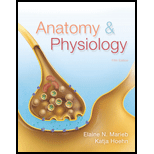
Anatomy & Physiology
5th Edition
ISBN: 9780321861580
Author: Marieb, Elaine N.
Publisher: Pearson College Div
expand_more
expand_more
format_list_bulleted
Concept explainers
Question
Chapter 3, Problem 7RQ
Summary Introduction
Introduction:
The solute pumping is a form of active transport that is attained by inducing a change in the protein channel and allows the molecules to cross through the membrane. This type of the pumping facilitate the transport of those molecules which are unable to cross lipid bilayer passively. As the name active transport indicates the requirement of energy, which is provided by the ATP to change the shape and position of carrier molecule.
Expert Solution & Answer
Want to see the full answer?
Check out a sample textbook solution
Students have asked these similar questions
Does active transport move order to disorder?
What type of transport is shown?
Does active transport move high to low concentration?
Chapter 3 Solutions
Anatomy & Physiology
Ch. 3 - Summarize the four key points of the cell theory.Ch. 3 - How would you explain the meaning of a generalized...Ch. 3 - What basic structure do all cellular membranes...Ch. 3 - Why do phospholipids, which form the greater part...Ch. 3 - What is the importance of the glycocalyx in cell...Ch. 3 - Prob. 6CYUCh. 3 - What is the energy source for all types of...Ch. 3 - What determines the direction of any diffusion...Ch. 3 - What are the two types of facilitated diffusion...Ch. 3 - What happens when the Na+-K+ pump is...
Ch. 3 - As a cell grows, its plasma membrane expands. Does...Ch. 3 - Prob. 12CYUCh. 3 - Which vesicular transport process allows a cell to...Ch. 3 - What process establishes the resting membrane...Ch. 3 - Prob. 15CYUCh. 3 - What term is used to indicate signaling chemicals...Ch. 3 - Which organelle is the major site of ATP...Ch. 3 - What are three organelles involved in protein...Ch. 3 - Compare the functions of lysosomes and...Ch. 3 - How are microtubules and microfilaments related...Ch. 3 - Prob. 21CYUCh. 3 - Prob. 22CYUCh. 3 - If a cell ejects or loses its nucleus, what is its...Ch. 3 - What is the role of nucleoli?Ch. 3 - What is the role of nucleoli?Ch. 3 - If one of the DNA strands being replicated reads...Ch. 3 - During what phase of the cell cycle is DNA...Ch. 3 - What are three events occurring in prophase that...Ch. 3 - Codons and anticodons are both three-base...Ch. 3 - How do the A, P, and E ribosomal sites differ...Ch. 3 - What is the role of DNA in transcription?Ch. 3 - What is the importance of ubiquitin in the life of...Ch. 3 - Prob. 33CYUCh. 3 - The smallest unit capable of life by itself is (a)...Ch. 3 - Prob. 2RQCh. 3 - Prob. 3RQCh. 3 - The term used to describe the type of solution in...Ch. 3 - Osmosis always involves (a) a selectively...Ch. 3 - Prob. 6RQCh. 3 - Prob. 7RQCh. 3 - The endocytotic process in which a sampling of...Ch. 3 - Prob. 9RQCh. 3 - The nuclear substance composed of histone proteins...Ch. 3 - The information sequence that determines the...Ch. 3 - Mutations may be caused by (a) X rays, (b) certain...Ch. 3 - The phase of mitosis during which centrioles each...Ch. 3 - Final preparations for cell division are made...Ch. 3 - The RNA synthesized on one of the DNA strands is...Ch. 3 - The RNA species that travels from the nucleus to...Ch. 3 - If DNA has a sequence of AAA, then a segment of...Ch. 3 - A nerve cell and a lymphocyte are presumed to...Ch. 3 - Prob. 19RQCh. 3 - Explain why mitosis can be thought of as cellular...Ch. 3 - Contrast the roles of ER-bound ribosomes with...Ch. 3 - Cells lining the trachea have whiplike motile...Ch. 3 - Name the three phases of interphase and describe...Ch. 3 - Comment on the role of the sodium-potassium pump...Ch. 3 - Differentiate between primary and secondary active...Ch. 3 - Cell division typically yields two daughter cells,...
Knowledge Booster
Learn more about
Need a deep-dive on the concept behind this application? Look no further. Learn more about this topic, biology and related others by exploring similar questions and additional content below.Similar questions
- What is extracellular fluid made up of?arrow_forwardWhich type(s) of vesicular transport is for nonspecific engulfment of fluid and materials from outside of the cell? a receptor-mediated endocytosis b exocytosis c pinocytosis d phagocytosis and pinocytosisarrow_forwardWhy is ATP required for active transport?arrow_forward
arrow_back_ios
arrow_forward_ios
Recommended textbooks for you
 Human Physiology: From Cells to Systems (MindTap ...BiologyISBN:9781285866932Author:Lauralee SherwoodPublisher:Cengage Learning
Human Physiology: From Cells to Systems (MindTap ...BiologyISBN:9781285866932Author:Lauralee SherwoodPublisher:Cengage Learning

Human Physiology: From Cells to Systems (MindTap ...
Biology
ISBN:9781285866932
Author:Lauralee Sherwood
Publisher:Cengage Learning
The Cell Membrane; Author: The Organic Chemistry Tutor;https://www.youtube.com/watch?v=AsffT7XIXbA;License: Standard youtube license